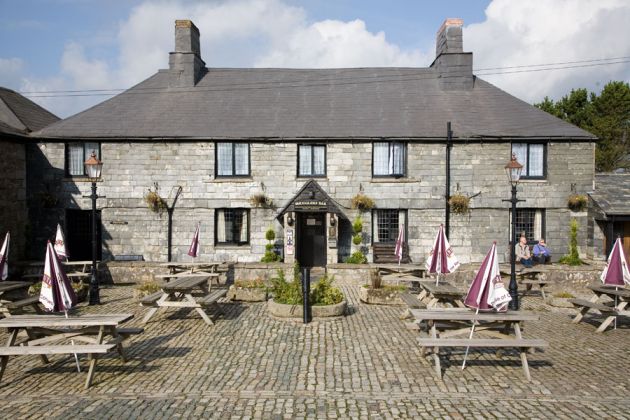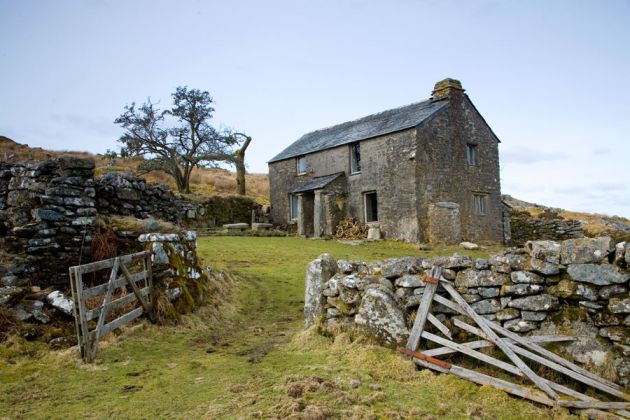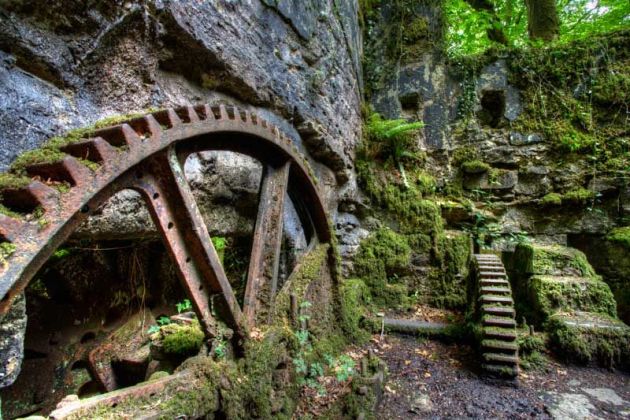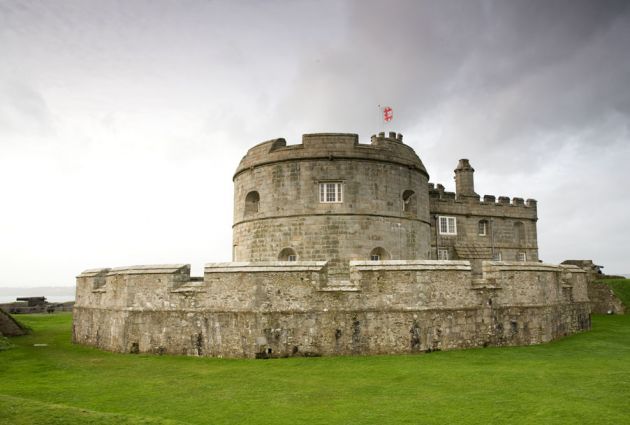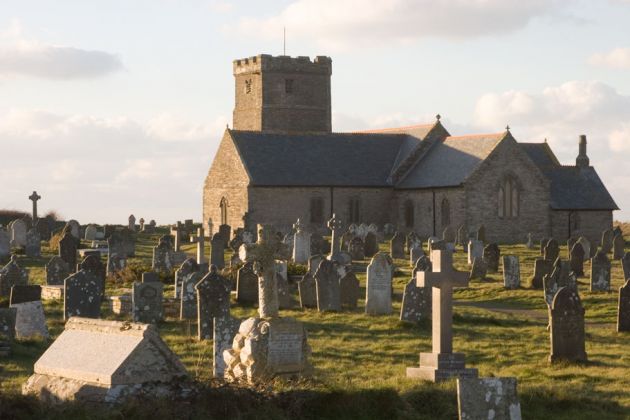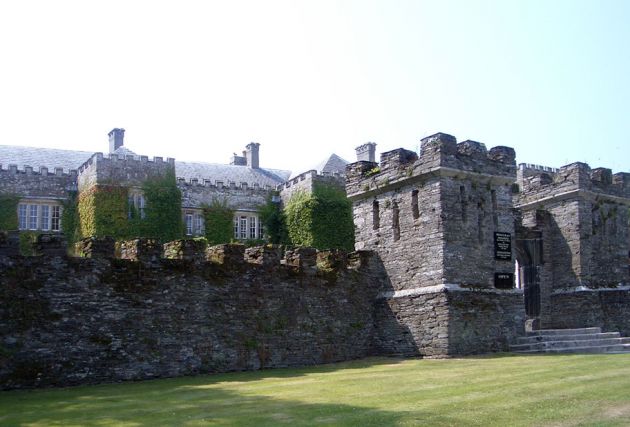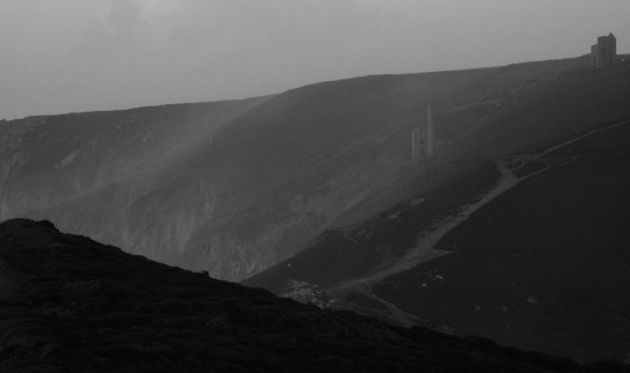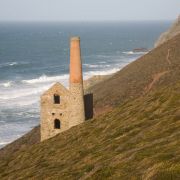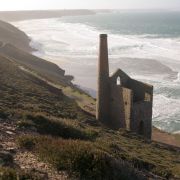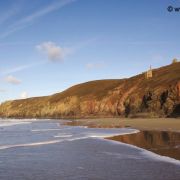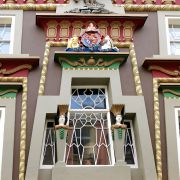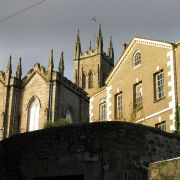BERRY POMEROY CASTLE
Berry Pomeroy
Devon
Although visible apparitions have not been experienced here for a few years, the persistent phenomena of the sound of a baby crying continues as a reminder of the ghost who used to haunt a particular arch. The phantom was that of a woman in a long, blue cape complete with a hood and was accepted as that of one of the Pomeroy daughters who murdered her own illegitimate child. According to several tourists and visitors to the ruins 'the feeling of absolute desolation, even stark evil, in those arches is overpowering'. In 1968 the curator was shown photographs taken by two separate groups of visitors which illustrate the phantom of a man in a tricorn hat and in the other the profile of a young woman in dark clothes. Both photographs were taken near the entrance to St. Margaret's Tower.
© Andrew Green
Berry Pomeroy
Devon
Although visible apparitions have not been experienced here for a few years, the persistent phenomena of the sound of a baby crying continues as a reminder of the ghost who used to haunt a particular arch. The phantom was that of a woman in a long, blue cape complete with a hood and was accepted as that of one of the Pomeroy daughters who murdered her own illegitimate child. According to several tourists and visitors to the ruins 'the feeling of absolute desolation, even stark evil, in those arches is overpowering'. In 1968 the curator was shown photographs taken by two separate groups of visitors which illustrate the phantom of a man in a tricorn hat and in the other the profile of a young woman in dark clothes. Both photographs were taken near the entrance to St. Margaret's Tower.
© Andrew Green
BIDEFORD ROAD
Torrington
Devon
The village of Little Torrington and the nearby town of Great Torrington were both, at one time, affected by visitations of a ghostly black dog. There have been no reports of this being witnessed recently. On 16 February, 1646 a force of 5, 000 men, the majority of whom were cavalry men under Lord Hopton, fought desperately to retain the town against the attacks of Lord Fairfax. In quoting from Battles in Britain by William Seymour, it is hoped to provide information relevant to the experiences of a few residents and a couple visiting the town during the Whitsun of 1976. 'After a brief struggle some of Hopton's cavalry, fighting in narrow streets unsupported by infantry, broke and would have been unable to hold the town even if its entire of stock of powder, stored in the church, had not blown up'.
Torrington
Devon
The village of Little Torrington and the nearby town of Great Torrington were both, at one time, affected by visitations of a ghostly black dog. There have been no reports of this being witnessed recently. On 16 February, 1646 a force of 5, 000 men, the majority of whom were cavalry men under Lord Hopton, fought desperately to retain the town against the attacks of Lord Fairfax. In quoting from Battles in Britain by William Seymour, it is hoped to provide information relevant to the experiences of a few residents and a couple visiting the town during the Whitsun of 1976. 'After a brief struggle some of Hopton's cavalry, fighting in narrow streets unsupported by infantry, broke and would have been unable to hold the town even if its entire of stock of powder, stored in the church, had not blown up'.
In 1976, Joan White of Chatham with her husband and two children stayed in the small cottage which had once served the village as a public house. She read with interest in a tourist brochure that 'a disastrous fire all but destroyed the town in the seventeenth century'but no other detail was provided.
On their last day Mrs. White was woken 'just before dawn', by a 'peculiar light in the bedroom. It swung from side to side', she said, 'moving from the back wall to the front. It was soft and golden, swinging in rhythm. When it reached the bedroom floor I heard a woman's voice shouting in a language I could not understand. Then two or three began to protest and then came the noise. It sounded like a group of motor-cyclist roaring past the house, the noise increasing with great speed in a roaring crescendo, then suddenly it stopped, leaving Devonshire peace to reign`. At breakfast her teenage children complained that they too had heard the noise. 'It sounded like a lot of motor-cyclists speeding up the tiny street', or, one might suggest, an explosion of gunpowder. But the streets were empty of humans at the time.
© Andrew Green
© Andrew Green
CHAMBERCOMBE MANOR
Ilfracoombe
Devon
According to James Turner in 'Ghost of the South West', a secret room was discovered in this fourteenth century building in 1865 which contained a four-poster bed with rotting curtains still drawn round it. When the material was moved aside the skeleton of a young woman was revealed. The remains were buried in the local churchyard after the usual enquires had failed to establish the cause of death or the identity of the girl. More recently, a tunnel was discovered which leads from the nearby manor farm to Hele Beach but whether either of the these incidents are connected with the haunting is unlikely to be established. The ghost remains unknown and, unfortunately, unseen, but her footsteps are still heard walking the corridors of the manor, to the chapel and to the cobbled courtyard. 'Weird moans', are also heard issuing from the former secret room, now only visible through a small window situated between two bedrooms.
© Andrew Green
Ilfracoombe
Devon
According to James Turner in 'Ghost of the South West', a secret room was discovered in this fourteenth century building in 1865 which contained a four-poster bed with rotting curtains still drawn round it. When the material was moved aside the skeleton of a young woman was revealed. The remains were buried in the local churchyard after the usual enquires had failed to establish the cause of death or the identity of the girl. More recently, a tunnel was discovered which leads from the nearby manor farm to Hele Beach but whether either of the these incidents are connected with the haunting is unlikely to be established. The ghost remains unknown and, unfortunately, unseen, but her footsteps are still heard walking the corridors of the manor, to the chapel and to the cobbled courtyard. 'Weird moans', are also heard issuing from the former secret room, now only visible through a small window situated between two bedrooms.
© Andrew Green
CHARDSTOCK CHURCH
Chardstock
Devon
Only two miles from the formerly haunted Forde Abbey and within a stone's throw of the Somerset border, travellers find the small village of Chardstock, once governed by the Diocese of Salisbury.
Chardstock
Devon
Only two miles from the formerly haunted Forde Abbey and within a stone's throw of the Somerset border, travellers find the small village of Chardstock, once governed by the Diocese of Salisbury.
No-one knows who the ghost is that haunts the area round the church or even if she is actually connected with it. However, one or two residents and an occasional friend have noticed a 'middle-aged woman in an old-style long grey dress'moving from the vicarage path towards the church. As she nears the gate she 'just fades away'. She has only been seen as dusk approaches 'usually about 5.30 p.m.'.
© Andrew Green
© Andrew Green
COWICK BARTON INN
Cowick Lane
Exeter
Devon
Formerly a farm which was renovated in 1963 to become a popular pub the 'Cowick Barton'is haunted, not really surprisingly, by a monk. The area on which the farmhouse existed once contained the monastery of St. Thomas. Mrs. Hayman and Mrs. Jenkins of nearby Wellington Road, told the 'Exeter Express' that the figure of the monk had appeared in their bedrooms. He has also been seen 'in broad daylight'by a small number of residents and a few visitors, walking across the fields to the river.
© Andrew Green
Cowick Lane
Exeter
Devon
Formerly a farm which was renovated in 1963 to become a popular pub the 'Cowick Barton'is haunted, not really surprisingly, by a monk. The area on which the farmhouse existed once contained the monastery of St. Thomas. Mrs. Hayman and Mrs. Jenkins of nearby Wellington Road, told the 'Exeter Express' that the figure of the monk had appeared in their bedrooms. He has also been seen 'in broad daylight'by a small number of residents and a few visitors, walking across the fields to the river.
© Andrew Green
EXETER CATHEDRAL
Bedford Street
Exeter
Devon
The mysterious figure of a nun haunts the cloisters here. Normally seen at about seven o'clock in the evening, she suddenly appears at a spot in the south wall of the nave, walks a few yards to the Church House and vanishes. No-one knows who she is. Although her head is slightly bowed down as if in deep thought, there is no suggestion of great tragedy or horrifying crime being associated with her. One of the most recent sightings was by a couple of members of a group of visiting tourists from France who expressed considerable interest in the nun and asked to which order she belonged.
© Andrew Green
Bedford Street
Exeter
Devon
The mysterious figure of a nun haunts the cloisters here. Normally seen at about seven o'clock in the evening, she suddenly appears at a spot in the south wall of the nave, walks a few yards to the Church House and vanishes. No-one knows who she is. Although her head is slightly bowed down as if in deep thought, there is no suggestion of great tragedy or horrifying crime being associated with her. One of the most recent sightings was by a couple of members of a group of visiting tourists from France who expressed considerable interest in the nun and asked to which order she belonged.
© Andrew Green
EXETER PRISON
New North Road
Exeter
Devon.
In 1973, two inmates serving long sentences were walking back to their cells when they noticed the figure of a middle-aged man moving along an upper gallery. On reaching a particular cell door he suddenly vanished. The two witnesses were so upset by this incident that they asked to see the Governor of the prison, who understandably dismissed the story as imagination. The two men, however, persisted in their report and the details they related were so identical that the officer was persuaded to examine some old architectural plans of the building, and earlier scheduled of inmates. All three men were surprised to learn that the figure was that of the last murderer to be kept in 'Death Row'the site of the haunting, before being hanged. The Governor immediately arranged for the affected cell and the one immediately below to be cemented over and the end of the gallery to be sealed off. Nevertheless, inexplicable footsteps are still heard in the locality.
© Andrew Green
New North Road
Exeter
Devon.
In 1973, two inmates serving long sentences were walking back to their cells when they noticed the figure of a middle-aged man moving along an upper gallery. On reaching a particular cell door he suddenly vanished. The two witnesses were so upset by this incident that they asked to see the Governor of the prison, who understandably dismissed the story as imagination. The two men, however, persisted in their report and the details they related were so identical that the officer was persuaded to examine some old architectural plans of the building, and earlier scheduled of inmates. All three men were surprised to learn that the figure was that of the last murderer to be kept in 'Death Row'the site of the haunting, before being hanged. The Governor immediately arranged for the affected cell and the one immediately below to be cemented over and the end of the gallery to be sealed off. Nevertheless, inexplicable footsteps are still heard in the locality.
© Andrew Green
EXETER UNIVERSITY
Prince of Wales Road
Exeter
Devon
In 1967 several students a few members of the staff were surprised to see the apparition of 'a tall man in a long , white coat' in one of the corridors of this modern university. His identity remains a mystery even though he was also witnesses in 1969, 1970, and 1973 but is thought to be one of the decorators who helped complete the buildings years earlier. There is a possibility, of course, that this might be another phantom of the living, for it is known that one of the team was intensely proud of his work.
© Andrew Green
Prince of Wales Road
Exeter
Devon
In 1967 several students a few members of the staff were surprised to see the apparition of 'a tall man in a long , white coat' in one of the corridors of this modern university. His identity remains a mystery even though he was also witnesses in 1969, 1970, and 1973 but is thought to be one of the decorators who helped complete the buildings years earlier. There is a possibility, of course, that this might be another phantom of the living, for it is known that one of the team was intensely proud of his work.
© Andrew Green
HOLCOMBE
Near Tiegnmouth
Devon
A stretch of this once major road continues to be haunted by the ghost of a middle-aged man in a long grey overcoat carrying a torch with which he 'flags down'evening motorists. Two local papers have published numerous reports by readers and other statements have been lodged elsewhere, including with the local police. The main area affected seems to be that in the Heatherton Grange Hotel region. A Mrs. Swithenbank of Taunton saw the figure as she drove round the bend of the road near the hotel and was convinced that she had collided with the man. When she went to investigate the road was found to be empty. One of the latest incidents was in 1978 when a motorcyclist had a similar experience but a week earlier a motorist had claimed that he had witnessed the phantom at White Ball, a few miles away.
© Andrew Green
Near Tiegnmouth
Devon
A stretch of this once major road continues to be haunted by the ghost of a middle-aged man in a long grey overcoat carrying a torch with which he 'flags down'evening motorists. Two local papers have published numerous reports by readers and other statements have been lodged elsewhere, including with the local police. The main area affected seems to be that in the Heatherton Grange Hotel region. A Mrs. Swithenbank of Taunton saw the figure as she drove round the bend of the road near the hotel and was convinced that she had collided with the man. When she went to investigate the road was found to be empty. One of the latest incidents was in 1978 when a motorcyclist had a similar experience but a week earlier a motorist had claimed that he had witnessed the phantom at White Ball, a few miles away.
© Andrew Green
OLD SMUGGLER'S INN
Coombe Cellars
Teignmouth
Devon
To account for the occasional witnessing of the apparition of an 'elderly woman'in one of the bedrooms is the belief that an overnight guest from London was murdered here in the 1700's. From the description given, she is certainly too well-dressed to be the average rural visitor, for she wears a 'pale blue gown and what appears to be jewellery round her neck'. Presumably it was for this that she was killed. The phantom was last seen or at least reported in August, 1972.
© Andrew Green
Coombe Cellars
Teignmouth
Devon
To account for the occasional witnessing of the apparition of an 'elderly woman'in one of the bedrooms is the belief that an overnight guest from London was murdered here in the 1700's. From the description given, she is certainly too well-dressed to be the average rural visitor, for she wears a 'pale blue gown and what appears to be jewellery round her neck'. Presumably it was for this that she was killed. The phantom was last seen or at least reported in August, 1972.
© Andrew Green
ROYAL CASTLE HOTEL
The Quay
Dartmouth
Devon
Occasionally the sound of horses'hooves and the crunching of coach wheels have been heard at 'about two in the morning', both by guests and resident staff. Footsteps are also part of the haunting which takes place in the hallway. The original building was extended some many years ago and now incorporates the original coach yard.
The Quay
Dartmouth
Devon
Occasionally the sound of horses'hooves and the crunching of coach wheels have been heard at 'about two in the morning', both by guests and resident staff. Footsteps are also part of the haunting which takes place in the hallway. The original building was extended some many years ago and now incorporates the original coach yard.

